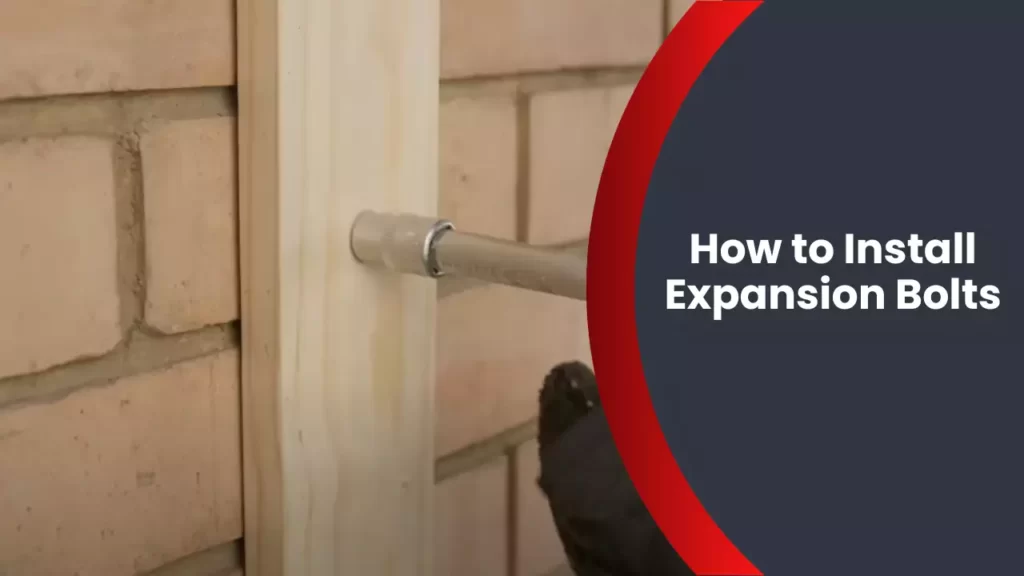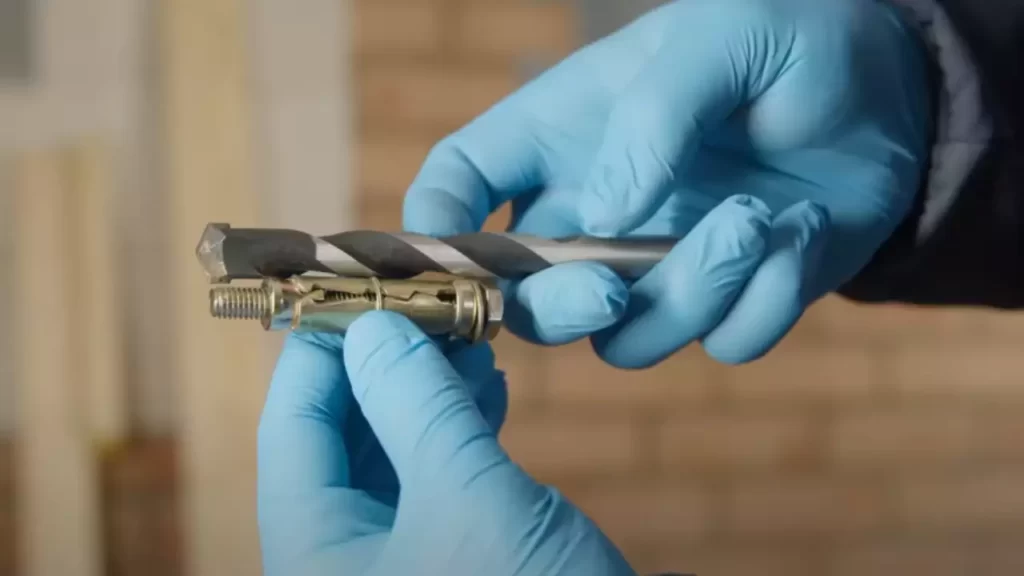To install expansion bolts, start by drilling a hole into the desired spot. Then, align the bolt with the hole and hammer it in until secure.
Preparation For Installing Expansion Bolts
Before you start installing expansion bolts, it is crucial to adequately prepare the surface and gather the necessary tools and equipment. Additionally, choosing the right type of expansion bolt is essential for a successful installation. In this section, we will discuss the different types of expansion bolts available in the market, factors to consider while selecting the appropriate bolt, and the tools and equipment required for installation. Let’s get started!
Types of Expansion Bolts
Expansion bolts are available in various types, each designed to suit specific applications and requirements. Here are some common types:
| Type | Description |
|---|---|
| Mechanical Expansion Bolts | These bolts rely on a mechanical expansion mechanism to secure objects. |
| Chemical Expansion Bolts | Chemical expansion bolts use a chemical reaction to create a secure grip. |
| Wedge Anchors | Wedge anchors are widely used for heavy-duty applications and offer excellent load-bearing capacity. |
| Sleeve Anchors | Sleeve anchors provide reliable anchorage by expanding inside the drilled hole. |
Selecting the Right Expansion Bolt
Choosing the appropriate expansion bolt is crucial for the success of your installation. Consider the following factors before making a selection:
- Load Capacity: Evaluate the weight or load that the bolt needs to support.
- Substrate Material: Different materials require specific types of bolts for optimal performance.
- Environmental Conditions: Consider the exposure to moisture, temperature variations, and corrosive elements.
- Installation Method: Determine whether the bolt will be installed through a pre-drilled hole or directly into the substrate.
Gather the Necessary Tools and Equipment
Before you begin the installation process, ensure you have the following tools and equipment:
- Drill Machine: A power drill with the appropriate drill bit size for the expansion bolt.
- Hammer: A sturdy hammer to insert the bolt into the drilled hole.
- Wrench or Spanner: A wrench or spanner to tighten the bolt securely.
- Dust Brush: A brush to clean any debris or dust from the drilled hole.
- Safety Gloves and Goggles: Personal protective equipment to ensure safety during the installation process.
Preparing the Surface
Preparation of the surface is critical to ensure a secure and long-lasting installation. Follow these steps:
- Clean the Surface: Use a brush or cloth to remove any dirt, dust, or loose particles from the surface where the bolt will be installed.
- Check for Debris: Inspect the drilled hole for any obstructions, such as leftover debris or broken fragments.
- Ensure Dryness: Make sure that the surface is dry before inserting the expansion bolt to prevent any corrosion or weak adhesion.
By properly preparing the surface, selecting the right expansion bolt, and gathering the necessary tools and equipment, you set the foundation for a successful installation process. In the next section, we will dive into the step-by-step process of installing expansion bolts.

Step-By-Step Guide To Installing Expansion Bolts
Are you planning a project that requires the use of expansion bolts? These versatile fasteners are perfect for securing heavy fixtures to solid walls or floors. However, proper installation is crucial to ensure their effectiveness and reliability. In this step-by-step guide, we will walk you through the process of installing expansion bolts, from marking the positions to tightening them securely.
1. Marking the positions
Before you begin drilling, it’s important to mark the exact positions where the expansion bolts will be placed. Use a pencil or a marker to make clear, visible marks on the wall or floor, ensuring they are aligned with your project requirements. Take your time and double-check the accuracy of your markings before proceeding.
2. Drilling the holes
Now that you have the positions marked, it’s time to drill the holes for the expansion bolts. Choose a suitable drill bit based on the material you are working with. For concrete or brick walls, a masonry drill bit is recommended, while a metal drill bit is suitable for metal surfaces. Ensure your drill is set to the correct speed and carefully drill straight into the marked positions.
3. Inserting the expansion bolts
Once the holes are drilled, it’s time to insert the expansion bolts. Carefully insert each bolt into its corresponding hole, ensuring they are flush with the surface. Use a hammer if needed to gently tap the bolts into place. Take care not to damage the threads or the surrounding area during this step.
4. Expanding the bolts
After inserting the bolts, it’s time to expand them. There are several methods to accomplish this, depending on the type of expansion bolts you are using. One common method is to tighten the bolt using a wrench or socket, which causes the inside of the bolt to push against the sides of the hole, creating a secure grip. Another method involves turning the bolt clockwise, which expands the outer sleeve against the wall.
5. Tightening the bolts
With the expansion bolts properly expanded, it’s crucial to tighten them securely to ensure maximum stability and strength. Using a wrench or socket, turn the bolts clockwise until they are tightly secured. Take care not to overtighten, as this can damage the bolts or the surrounding material. Double-check each bolt to ensure they are evenly tightened and aligned with your project requirements.
By following this step-by-step guide, you can confidently install expansion bolts for your project. Remember to take your time, use the proper tools and techniques, and ensure each step is executed accurately. With proper installation, expansion bolts will provide the secure and reliable fastening your project requires.

Tips And Best Practices For Installing Expansion Bolts
When it comes to installing expansion bolts, following proper techniques and best practices is essential for ensuring their effectiveness and longevity. In this section, we will discuss some useful tips and best practices for installing expansion bolts. These guidelines cover areas such as proper alignment and spacing, using the appropriate torque, ensuring proper depth, testing the strength, and ensuring safety. By adhering to these tips, you can ensure a secure and reliable installation of expansion bolts.
Proper alignment and spacing
Proper alignment and spacing are crucial for the successful installation of expansion bolts. To achieve proper alignment, ensure that the expansion bolt is completely vertical and perpendicular to the surface. Any deviation from the vertical alignment can significantly affect the integrity of the installation. It is also important to maintain the recommended spacing between expansion bolts to distribute the load evenly and prevent any uneven stress on the surface.
Tips for ensuring accurate alignment and proper spacing
- Use a level to check the alignment of the expansion bolt before installation.
- Mark the desired spacing for the expansion bolts on the surface to ensure precise positioning.
- Avoid installing expansion bolts too close to edges or corners to prevent any cracking or weakening of the surface.
Using the appropriate torque
Applying the correct torque to the expansion bolt is crucial for ensuring its effectiveness. Insufficient torque can result in a loose installation, while excessive torque can damage the bolt or the surface. It is essential to follow the manufacturer’s guidelines for the recommended torque values for each specific type and size of expansion bolt.
Guidelines for determining the correct amount of torque
- Refer to the manufacturer’s instructions for the recommended torque values.
- Use a torque wrench to accurately apply the desired torque.
- Ensure the torque is evenly distributed during the tightening process.
Ensuring proper depth
Achieving the correct depth during installation is crucial for the optimum performance of expansion bolts. The depth affects the load-bearing capacity of the bolt and its ability to securely anchor into the surface. It is important to determine and adhere to the recommended depth specified by the manufacturer for each type and size of expansion bolt.
Techniques for achieving the correct depth during installation
- Measure the length of the expansion bolt and mark the corresponding depth on the drill bit to ensure accurate drilling.
- Regularly clean out the drilled hole to remove any debris or dust that may affect the depth and installation.
- Use a depth stop on the drill to prevent drilling beyond the desired depth.
Testing the strength
After installation, it is important to test the strength and stability of the expansion bolts to ensure their reliability. Proper testing methods will confirm that the bolts can withstand the intended load and provide the necessary anchorage.
Methods for testing the strength and stability of the installed bolts
- Apply a gradually increasing load to the installed bolts and observe for any signs of movement or failure.
- Use a tensionometer to measure the tension or load-bearing capacity of the expansion bolts.
- If required, consult with a structural engineer for specialized testing methods and equipment.
Ensuring safety
Safety should always be a top priority during the installation of expansion bolts. By taking appropriate precautions, you can minimize the risk of accidents or damage.
Precautions to take while installing expansion bolts
- Wear appropriate personal protective equipment, such as safety glasses and gloves, to protect against any flying debris or potential injury.
- Ensure that the chosen surface can bear the intended load and is suitable for the installation of expansion bolts.
- Avoid overloading the expansion bolts beyond their recommended load-bearing capacity.
Frequently Asked Questions
How Are Expansion Anchors Installed?
To install expansion anchors, follow these steps: 1. Drill a hole in the desired location using a power drill. 2. Insert the expansion anchor into the hole until it is flush with the surface. 3. Place the fixture or object over the anchor.
4. Tighten the anchor with a wrench or screwdriver until it is securely in place. 5. Test the anchor’s stability by applying pressure or pulling on the fixture.
When Should I Use Expansion Bolts?
Expansion bolts should be used when you need to securely anchor heavy objects to masonry or concrete surfaces. They provide strong and reliable support, especially when dealing with heavy loads or in seismic areas. They are ideal for applications like installing handrails, shelving units, or mounting equipment on walls.
How Do You Anchor Bolts Into Concrete?
To anchor bolts into concrete, follow these steps: 1. Drill a hole in the concrete using a hammer drill and the correct size of drill bit. 2. Insert a wedge anchor or expansion anchor into the hole. 3. Tighten the anchor by turning the nut with a wrench until it is securely in place.
4. Ensure the bolt is level and aligned before filling the hole with epoxy or grout. 5. Allow the epoxy or grout to cure completely before applying any load to the anchor.
Are Expansion Bolts Strong?
Yes, expansion bolts are strong. They offer reliable anchorage and can withstand heavy loads. These bolts expand when tightened, creating a secure connection to the material they are being inserted into. They are commonly used in construction and engineering projects to provide a strong and stable support system.
Conclusion
Installing expansion bolts is a straightforward process that requires careful preparation and the right tools. By following these step-by-step instructions and adhering to safety precautions, you can securely anchor heavy fixtures and ensure their stability. Remember to choose the appropriate type of expansion bolt for your specific application and consult a professional if you’re unsure.
With a little patience and attention to detail, you can successfully install expansion bolts and enjoy a sturdy and reliable attachment for your project.
